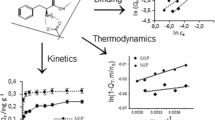Abstract
A phenylalanine (Phe) imprinted polymer was prepared by the wet phase inversion method to investigate the optimum preparation condition which endows the polymer matrix with prominent adsorption selectivity. The addition of a large amount of porogen (dimethyl sulfoxide: DMSO) was needed to form macrovoids in the polymer matrix. For the high adsorption selectivity of the polymer matrix, a complex between functional monomers and a template molecule must be formed before the copolymerization of acrylomtnle (AN: crosslinker) and acrylic acid (AA: functional monomer). The formation of a phenyl group in the polymer matrix by the coupling reaction between D-Phe and AA seemed to cause the reverse adsorption selectivity of the polymer matrix. The adsorption selectivity of the Phe imprinted polymer was dependent on the pH of the racemate solution. The adsorption selectivity of the D-Phe imprinted polymer prepared by the post implanting method reached 11 at pH 2 and showed a reverse adsorption selectivity at pH 4 and 6.
Similar content being viewed by others
References
Chen, Y, Kele, M., Quinones, L, Sellergren, B. and Guiochon, G.,“Influence of the pH on the Behavior of an Imprinted Polymeric Stationary Phase-Supporting Evidence for a Binding Site Model,”J. Chromatg. A,927,1 (2001).
Hong, J. M., Andersson, P. E., Qian, J. and Martin, C. R.,“Selectively-Permeable Ultrathin Film Composite Membranes Based on Molecularly-Imprinted Polymers,”Chem. Mater.,10(4), 1029 (1998).
Jin, J. S.,“Preparation of HPLC Chiral Stationary Phases and Resolution of Enantiomers,” PhD Thesis, Pusan National University, Korea (1999).
Kapoor, A. and Viraraghavan, T.,“Heavy Metal Biosorption Sites in”Aspergillus niger,” Bioresource Technol.,61, 221 (1997).
Kim, K. S. and Jung, I. H.,“The Permeability Characteristics of Non-Porous Membrane by C7H5F3/S1H4, Plasma Polymeric Membrane,”Korean J. Chem. Eng.,17, 149 (2000).
Kim, K. S, Jeon, B. J. and Jung, I. H.,“Preparation of CHF3 Plasma Polymeric Composite Membrane and Characteristics of Surface Modification,/rdKorean J. Chem. Eng.,17, 33 (2000).
Kobayashi, T., Wang, H. Y and Fujii, N.,“Molecular Imprinting of Theophylline in Acrylontrile-Acrylic Acid Copolymer Membrane,”Chem. Lett,10, 927 (1995).
Mathew-Krotz, J. and Shea, K. J.,“Imprinted Polymer Membranes for the Selective Transport of Targeted Neutral Molecules,”J. Am. Chem. Soc.,118, 8154 (1996).
Mayes, A. G. and Mosbach, K.,“Molecularly Imprinted Polymer Beads: Suspension Polymerization using a Liquid Perfluorocarbon as the Dispersing Phase,”Anal. Chem.,68(21), 3769 (1996).
Ohkubo, K., Urata, Y, Hirota, S., Honda, Y and Sagawa, T.,“Homogenous and Heterogenous Esterolytic Catalyses of Imidazole-containing Polymers Prepared by Molecular Imprinting of a Transition-state Analogue,”J. Mol. Catal.,87, L21 (1994).
Park, J. K. and Seo, J. I.,“Characteristics of Phenylalanine Imprinted Membrane Prepared by the Wet Phase Inversion Method,”Korean J. Chem. Eng.,19, 940 (2002).
Puranik, P. R. and Paknikar, K. M.,“Biosorption of Lead, Cadmium, and Zinc byCitrobactor Strain MCM B-181: Characterization Studies,”Biotechnol. Prog.,15, 228 (1999).
Ramstrom, O., Ye, L. and Gustavsson, P.-E.,“Chiral Recognition by Molecularly Imprinted Polymers in Aqueous Media,”Chromatographia,48, 197 (1998).
Robinson, D. K. and Mosbach, K.,“Imprinting of a Transition State Analogue Leads to a Polymer Exhibiting Esterolytic Activity,”J. Chem. Soc, Chem. Commun.,14, 969 (1989).
Sohn, W. I., Koo, J. K. and Oh, S. J.,“Permeation of Single and Mixed Gases through Composite Membranes Prepared by Plasma Polymerization of Fluorocarbon Compounds,”Korean J. Chem. Eng.,17, 678 (2000).
Wang, H. Y, Kobayashi, T., Fukaya, T. and Fujii, N.,“Molecular Imprint Membranes Prepared by the Phase Inversion Technique. 2. Influence of Coagulation Temperature in the Phase Inversion Process on the Encoding in Polymeric Membranes,”Langmuir,13, 5396 (1997).
Whitcombe, M. J., Rodriquez, M. E., Villar, P. and Vulfson, E. N.,“A New Method for the Introduction of Recognition Site Functionality into Polymers Prepared by Molecular Imprinting: Synthesis and Characterization of Polymeric Receptors for Cholesterol,”J. Am. Chem.Soc.,111, 7105 (1995).
Yoshikawa, M., Fujisawa, T. and Izumi, J.,“Molecularly Imprinted Polymeric Membranes Having EFF Derivatives as a Chiral Recognition Site,”Macromol. Chem. Phys.,200, 1458 (1999).
Yoshikawa, M., Fujisawa, T, Izumi, I, Kitao, T. and Sakamoto, S.,“Molecularly Imprinted Polymeric Membranes Involving Tetrapeptide EQKL Derivatives as Chiral-recognition Sites Toward Amino Acids,”Anal. Chim. Acta,365, 59 (1998).
Author information
Authors and Affiliations
Corresponding author
Rights and permissions
About this article
Cite this article
Park, J.K., Kim, S.J. & Lee, J.W. Adsorption selectivity of phenylalanine imprinted polymer prepared by the Wet Phase Inversion Method. Korean J. Chem. Eng. 20, 1066–1072 (2003). https://doi.org/10.1007/BF02706937
Received:
Accepted:
Issue Date:
DOI: https://doi.org/10.1007/BF02706937




